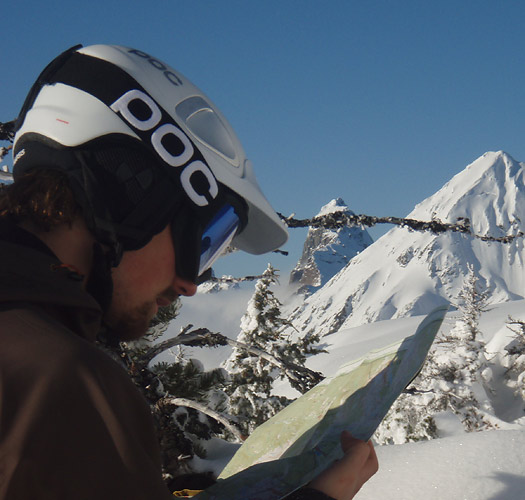I hardly ever ski without my helmet — at the resort or while backcountry skiing. That is partly to keep my parents happy, but I also just feel more comfortable while I’m skiing with a helmet as opposed to just a beanie (maybe that’s a bad thing). I had my last helmet for quite a few years; the vents had to be closed with a multitool and the earflaps recently fell off. Time for a new head shell. Luckily a POC Synapsis helmet and Iris X goggles showed up at my doorstep. My roommates here in Bellingham immediately dubbed it the “space helmet” and they are right, it is white with chrome inlets and looks like it should be going a million miles an hour.

POC Synapsis helmet and Iris X goggles. That is Mt. Larrabee on the right, and American Border peak on the left.
At 11.2 oz, the Synapis is one of the lightest certified ski helmets out there, and that’s with the visor. Most other helmets weigh in at around 1 pound, even some climbing helmets. POC accomplishes this by using bicycle helmet type construction, only with a ballistic nylon liner that adds durability for multiple impacts (bicycle helmets are typically good for one whack). The Synapis shell does feel slightly heavier duty than my old ski helmet, which got scratched and dented pretty quick just from everyday use. Time will tell how effective this is, but it sure saves weight.
The POC helmet is also smaller than my old helmet so it fits in my pack nicely. Although it only has two small vents, the POC hasn’t been too hot while skiing downhill. As for the uphill, even helmets with loads of venting are way too warm for most backcountry skiing hikes, so in my mind that isn’t a big issue. The POC vents can be closed with a small velcro flap inside the helmet, although the helmet has to be off your head to do this.
I paired POC Iris X goggles with the Synapsis helmet. The Iris X lenses are nice and big, with an emphasis on creating a large field of vision which is awesome for backcountry skiing. Interestingly, there are none of the common vent holes in the top of the lens. Instead the venting is built into the goggle frame. The only time I have had the goggle fog up is when I store it in its case without drying them out. As with everything POC makes, the goggles are super high tech. The inner lens is less impact resistant than the outer lens, but is more fog resistant, and the outer lens is super strong and impact resistant. The bright blue mirror lenses are great for photos as well. The lenses are also removable, which is always a nice feature.
As always, the editor here at WildSnow.com is harassing me to find a downside to this gear. He doesn’t want us publishing what he calls “puff.” Okay, one thing that comes to mind is the street price on the Synapsis helmet: at $150.00 a bit pricey. But saving ounces on your head is kind of like saving them on your feet — you can really feel the difference. The padding on the inside is pretty minimal; although it feels comfy to me, it might not work for someone with a differently shaped head. Only downside I could come up with for the Iris X goggles is they might not fit other brands of helmets that well, so be sure to have a good return option if you buy them mail order and are not using a POC helmet.
Though I didn’t use a helmet on Denali this spring, I did use the POC Iris X goggles. While Lou Sr. seemed to constantly be fighting fogging in his “goggles with no name” my POCs stayed clear and true. ‘Nuf said.
Shop for yours here.
Louie Dawson earned his Bachelor Degree in Industrial Design from Western Washington University in 2014. When he’s not skiing Mount Baker or somewhere equally as snowy, he’s thinking about new products to make ski mountaineering more fun and safe.
